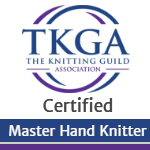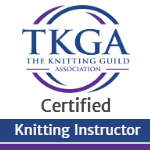Bust Darts!!
(Note, I will talk through this using inches, but this works just fine using cm instead.)
Also, I didn’t have time to create pretty images to go with this, but I will try to come back soon and add some images to help you visualize these things!
If you find sweaters ride up in front, then you might need to consider adding bust darts to your sweaters. These add extra length in the front only to account for the added length needed in the front to go over your curves, and will allow for the hem to lie parallel to the floor. These are worked via short rows.
To determine how much adjustment you need, measure from your neck/shoulder bend at the side of your neck, down over your bust to your underbust. Measure from the same neck spot down your back to the same underbust line (it can help to run a string around your underbust, making sure it is level, to be sure you are measuring to the same spot at your underbust).
Take the difference of these two measures, and subtract 2 inches. (Knitting stretches, so about 2 inches is usually overcome by knitting’s stretch, plus ease in the sweater- if you are working a sweater with zero or negative ease, then don’t subtract that 2 inches, if you are working a high-ease sweater (6-10″ + pf ease), you can subtract more than 2 inches.) Whatever you have left is the amount you might want to consider adding via bust darts. If the difference is zero, then you are all set and shouldn’t need bust darts. If it is one or higher, you might want to consider adding some.
Adding them can be tricky depending on the stitch pattern of your sweater. Stockinette is the easiest to add them to!
Where to add them: find the vertical measure to your full bust from your neck. When working top-down, you will want to start your short rows about a half an inch to an inch past this point. When working bottom-up, you will need to do some math to figure out when to start, and this will depend on the planned total length of the sweater. Add about a half an inch to an inch to your full bust vertical and then subtract this from the total length of the sweater, and that is where you will start your bust dart rows. A basic rule of thumb is to place the short row section about 1-3″ below the underarm.
Top-down knitting will begin with shorter short rows centered over the bust, and will get longer and longer.
Bottom-up knitting will begin with the longest short rows and will get shorter and shorter, ending with the shortest rows centered over the bust.
Here is the math:
How many rows: Take the measurement you found for how much adjustment you need, and multiply that by your row gauge (rows/inch). Make this number an EVEN number, because we work short row pairs. Subtract 2 rows (for the last two rows to complete the short row section.) Divide by 2 to get your number of turns (T) (or pairs, each row in a pair will be the mirror of its mate.)
How wide for the shortest rows (A): Measure the distance between the points of your breasts. Add 2 inches to this (so that the darts don’t give points where we don’t want them!) Multiply this measure by your stitch gauge (sts.inch). If your stitch count in the front of your sweater is even, make this even, if the stitch count in the front of your sweater is odd, make this odd.
Stitches from edge for the widest rows (B): Take 1 inch times your sts/inch — basically your stitches per 1″ or 10cm will be how close you get to the side seam with your widest rows.
Dart width (C): Take the total sts of the front of your sweater, subtract A sts, subtract Bx2 sts. Divide this number in half — this is the number of stitches involved in the dart on each side of the chest.
Now we need to calculate our steps for the short rows. We have to figure out how many sts to leave unworked with each turning.
Sts to leave unworked for each short row (D): Take C divided by T. This might be a fraction or decimal, that’s ok. Round up and down to the nearest whole numbers, and these will be the two numbers you work with. Play around with these to figure out the proper number of each to get your total dart sts of C.

Example: 50 sts per dart, with 6 turns, so 50/6 = 8.333. We will work some sets with 8 sts between turns and some with 9 sts between turns. (Hint: Since we got a decimal of .333, that means one third of the rates will be at the higher rate.) You can alternate to get a more straight line (8, 9, 8, 9, 8, 8) or work the one rate first then the other (9, 9, 8, 8, 8, 8). I find it looks best when doing this to place the faster rates towards the center of the bust and the slower rates towards the outer edges of the bust. This makes for a curved line UP towards the bust instead of getting a line that points down. We don’t want a droopy looking bust dart line!
That’s all the math! Now, what does this look like in practice?
SHORT ROWS
You can use wrap and turn short rows, or German short rows, or pretty much any short row method you like. I will keep the directions below generic, you will have to figure out what your chosen method will dictate for the actual directions.
Bottom Up
Work across a RS row to one inch from the side seam (your B number of sts.). Turn, working your chosen short row.
Work across a WS row to one inch from the other side seam (your B number of sts.) Turn, working your chosen short row.
Next Row (RS): Work to D sts from the last short row worked and turn.
Next Row (WS): Work to D sts from the last short row worked and turn.
Repeat these last two rows until you have worked your T pairs of turns.
Next Row (RS): Work across all sts, resolving short rows.
Final Row (WS if flat, RS if in the round): Work across sts, resolving the rest of the short rows.
Top Down
Work across a RS row to your bust point — (B plus A plus C sts). Turn, working your chosen short row.
Work across a WS row A sts. Turn, working your chosen short row.
Next Row (RS): Work to D sts past the last short row worked and turn.
Next Row (WS): Work to D sts past the last short row worked and turn.
Repeat these last two rows until you have worked your T pairs of turns. You should end an inch from the side seams.
Next Row (RS): Work across all sts, resolving short rows.
Final Row (WS if flat, RS if in the round): Work across sts, resolving the rest of the short rows.
I know that was a lot of math, and a lot of words thrown at you, but I hope it is helpful!!
Let me know what you think.
Happy Knitting!!





Wow! That was intense. I had to read through it a couple of times but it makes sense. Thanks for the formula. Another item on my “to learn/make swatch” list. 🙂
It is a little intense! Glad it makes sense, though!
Thank you, Heather. Clear explanation – your post was very helpful!
You’re welcome! I’m glad it was helpful!